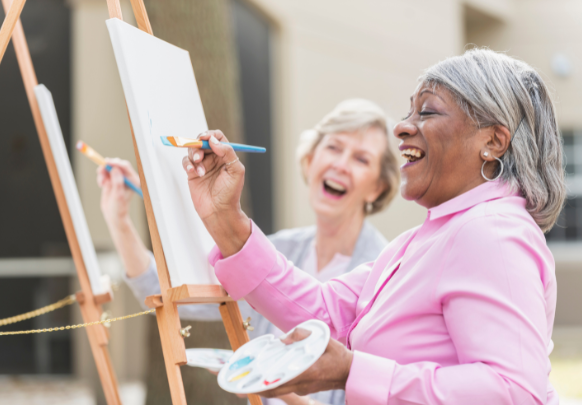Art as Therapy: How Creativity Supports Senior Mental Health
Art isn’t just for galleries or professionals—it’s for everyone. For seniors, the act of creating something can be profoundly therapeutic. It offers a chance to reflect, express emotions, and stay mentally active, all while enjoying the process of making something unique and meaningful.
Lawrence Hobart
4/22/20252 min read


Welcome back to CareTec’s special series on senior health and wellness! We’ve been journeying through practical, thoughtful ways to support seniors in living happy, healthy lives—physically, mentally, and emotionally. As always, CareTec is here to support both caregivers and seniors with AI-driven tools that help monitor health and enhance everyday care.
In our last blog, “Music and Memory: How Tunes Can Boost Senior Wellbeing,” we explored the incredible impact music can have on memory, mood, and emotional connection. We saw how a simple song can spark joy, recall cherished memories, and even promote gentle movement.
This time, we’re turning to another enriching and expressive outlet—art. Whether it’s painting, drawing, sculpting, or crafting, engaging in creative activities has been shown to improve mental health, reduce stress, and give seniors a joyful sense of purpose. Let’s explore why artistic expression can be so powerful for older adults.
Art as Therapy: How Creativity Supports Senior Mental Health
Art isn’t just for galleries or professionals—it’s for everyone. For seniors, the act of creating something can be profoundly therapeutic. It offers a chance to reflect, express emotions, and stay mentally active, all while enjoying the process of making something unique and meaningful.
Benefits of Art for Seniors
Engaging in artistic activities offers a wide range of mental, emotional, and even physical benefits:
Reduces stress and anxiety – Art can have a calming effect, offering a gentle way to release tension and promote relaxation.
Improves focus and cognitive function – Creative tasks help stimulate different areas of the brain, enhancing problem-solving skills and attention to detail.
Boosts mood and self-esteem – Completing a creative project brings a sense of accomplishment and pride.
Enhances hand-eye coordination – Drawing, painting, and crafting support fine motor skills and dexterity.
Encourages social connection – Group art activities or sharing projects with friends and family can reduce feelings of isolation.
Simple Creative Activities Seniors Can Enjoy
You don’t need expensive supplies or advanced skills to start exploring art. Here are some easy ways for seniors to engage creatively:
Watercolor painting – Relaxing and beginner-friendly, it’s a soothing way to explore color and expression.
Adult coloring books – These offer structured creativity with calming benefits, especially for those who may feel unsure about free-form drawing.
Clay or playdough sculpting – Tactile and fun, this activity can also improve finger strength and coordination.
Collage or scrapbooking – A wonderful way to tell stories through photos, clippings, and other keepsakes.
Craft kits – From simple sewing projects to card making, kits can offer structure and inspiration.
Guided art classes – Many community centers or online platforms offer beginner art tutorials tailored for seniors.
When to Be Mindful
While art is a gentle and joyful activity, a few considerations can make it more enjoyable and accessible:
Adjust materials for mobility – Use larger grips on brushes or pens for those with arthritis or limited hand strength.
Minimize mess and frustration – Choose low-maintenance materials like colored pencils or water-based paints.
Encourage creativity over perfection – Remind seniors (and caregivers!) that it’s about the process, not the outcome.
How Technology Can Help
Digital drawing apps and virtual art classes offer exciting ways for seniors to explore creativity, even from the comfort of home. AI tools can also help monitor emotional engagement and stress levels, giving caregivers insights into how creative activities affect a senior’s overall well-being.
Disclaimer
This blog is intended for informational purposes only and is not a substitute for professional medical advice, diagnosis, or treatment. If you or a loved one is experiencing significant emotional or mental health challenges, please consult a healthcare provider.
©2025 CareTec.AI
Melbourne: 101 Collins St Melbourne VIC 3000 +613 9999 7379
Sydney: 2 Chifley Square, Sydney NSW 2000 +612 8880 0307
Queensland: 46 Cavill Ave, Surfers Paradise QLD 4217 +617 3667 7473
Texas: 200 W 6th St, Austin, TX 78701 +1 (737) 7101 776
London: 22 Bishopsgate, London EC2N 4AJ +44 (020) 4577 4024


